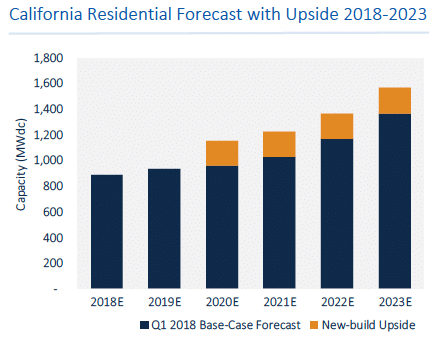GTM Research has officially updated its forecast for California’s distributed solar market, estimating that the state will add around 650 MW-DC of additional solar across the 2020-2023 timeframe as a result of the recent approval of a building code that mandates solar on all new homes starting in 2020.
 This will increase the state’s residential market by 14% across these four years, with a big boost in 2020, when the market is expected to increase to around 1.2 GW.
This will increase the state’s residential market by 14% across these four years, with a big boost in 2020, when the market is expected to increase to around 1.2 GW.
It is important to note that this forecast only includes solar on new single-family homes, whereas per the new code the California Energy Commission (CEC) has mandated solar for every new residential unit, including apartments and condominiums.
In fact, new single-family homes represented only slightly more than half the new units built in 2017, meaning that the mandate could result in hundreds of megawatts of solar each year in addition to that included in this forecast update.
GTM Research Senior Analyst Austin Perea told pv magazine that there is “definitely going to be an impact” in terms of these larger installations, but also notes that this is harder to forecast, as there is “not as good of data”.
The code does provide some flexibility to meet this requirement using community solar, so it is probable that this additional solar will be a mix of larger rooftop systems and community solar.
GTM Research says that this mandate could also provide opportunities for building-integrated solar products including Tesla’s Solar Roof. In addition to Tesla, Perea says that this could provide opportunities for SunPower, which has done a number of deals with new housing developments.
“Tesla’s BIPV and SunPower, given their relationships with existing housing developers, would probably be two of the companies that will benefit the most from this,” notes Perea.
However, he predicts there will be opportunities for a wide swath of the “middle tier” of installers. “Specifically the installers that have some level of RFP finesse are probably going to be able to out-bid and out-install the smaller regional installers,” states Perea.
This content is protected by copyright and may not be reused. If you want to cooperate with us and would like to reuse some of our content, please contact: editors@pv-magazine.com.









By submitting this form you agree to pv magazine using your data for the purposes of publishing your comment.
Your personal data will only be disclosed or otherwise transmitted to third parties for the purposes of spam filtering or if this is necessary for technical maintenance of the website. Any other transfer to third parties will not take place unless this is justified on the basis of applicable data protection regulations or if pv magazine is legally obliged to do so.
You may revoke this consent at any time with effect for the future, in which case your personal data will be deleted immediately. Otherwise, your data will be deleted if pv magazine has processed your request or the purpose of data storage is fulfilled.
Further information on data privacy can be found in our Data Protection Policy.